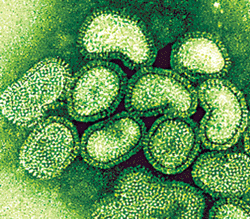How To Survive a Flu Outbreak
Thanks to The Survival Spot Blog for this post
Download to PDF, send to everyone you know
1. Stay informed
In addition to taking the precautions below, staying informed as the spread of the outbreak is vital to the danger level at this moment in time. Unlike during the Spanish flu outbreak in 1918, we have access to information as it happens. Check the Google Map below to see where Swine flu has occurred and if it is close to you.
Outbreak Map
2. AVOID GETTING SICK!
Don’t expect that there will be a vaccine for everyone, there is a limited supply
3. Prepare for Quarantine

In a severe crisis, travel restrictions, curfews and perhaps quarantines may be implemented. To be prepared for a situation like this:
- Have 2-3 weeks of clean drinkable water on hand
- Have 2-3 weeks of food (try to get vitamin rich foods, smoothie drinks, fruits etc.)
- Make sure you have proper medication and hygiene supplies at home
- Have at least $100 of cash
- In case of power outages or disruption of services like gas, have your own lanterns and propane stoves for cooking and light at nighttime
4. Isolate yourself
Even if you are a healthy individual, avoiding people and public places as much as possible can prevent or reduce the chance of catching the flu. Since many viruses can be passed several days before symptoms occur, you could be sick before you even know it.
- Keep a distance of 3-6ft from others at all times
- Avoid going to public events, avoid large crowds (sporting events, theaters etc.)
- Avoid going out, unless necessary. When you do keep it to a minimum
- DON’T leave your local area!! (Most people who have gotten swine flu were visiting Mexico)
- Avoid eating out; the crowds and the sanitization of utensils could cause infection
- Keep kids home from school, if possible
- Work from home, if possible
- If you have food and water storage, this is the time to use it (some of it), this will reduce your contact with others by avoiding grocery stores
- If you don’t have food and water stored, go buy some.
5. Hygiene
- Wash Your Hands frequently, especially after touching public doorknobs, pens or shopping carts
- Carry Hand Sanitizer, Use frequently
- Sanitize your car, work station and home with bleach or alcohol based cleaners
- Avoid touching common germ sources
- Wear latex gloves when out in public
- DON’T share drinks or utensils
- Wear face masks when out in public; use a mask with an N95 rating or higher
- Wear glasses or goggles (airborne pathogens can get into your eyes)

6. Health
- Get a good night’s sleep, every night
- Buy food from local sources, clean or cook vigorously
- Avoid smoking, drinking, and drugs (they reduce your immune function)
- Start taking Vitamin C, D, Garlic, Elderberry, Oil of Oregano and Echinacea
- Avoid salty foods and junk foods
- Buy and take Colloidal Silver
- Exercise regularly
- Upon signs of infection, avoid others, cough into your arm or a handkerchief and see a doctor immediately (common flu vaccines can have severe side effects, avoid getting sick so you will not have to take these
If you do get infected consider setting up a Quarantine room. This is no substitute for professional medical care but it could be good during disruption of services.








3 comments:
Once again I find the best info there is on this subject. Thanks for providing the latest and greatest news and updates.
Thanks for stopping in Bullseye!
Good article.
Just want to point out that N95 masks have virtually no ability to protect the wearer from other people’s airborne germs. This is the rule of thumb: "If it’s not air-tight, it’s not right!"
http://www.naturalnews.com/026160.html
Post a Comment